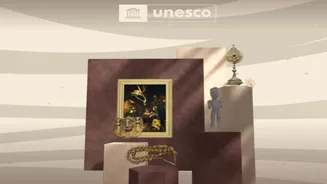Museums offer us a window into humanity’s past, allowing us to journey through different eras by observing the objects they preserve. The paintings, sculptures, tools, and artefacts on display tell stories
of human evolution, the cultures that once thrived, and the heritage passed down by our ancestors.
From the age of cave dwellers to the Indus Valley Civilisation and now to the era of artificial intelligence, museums reflect humankind’s timeless desire to create, innovate, and preserve the extraordinary.
Yet, alongside the passion to create and collect, there also emerged a darker impulse, the pursuit of profit and possession. This greed has led to the theft, looting, and illicit trafficking of countless cultural treasures, depriving communities of their heritage and history.
To shine a light on these stolen artefacts, raise global awareness, and promote international cooperation for their recovery, UNESCO has turned to technology for a powerful solution.
At the World Conference on Cultural Policies and Sustainable Development (MONDIACULT 2025) held in Barcelona on September 29, 2025, the organisation unveiled the Virtual Museum of Stolen Cultural Objects — a groundbreaking digital platform dedicated to protecting and restoring the world’s cultural heritage.
Let’s take a closer look at the idea behind this museum and why it holds such importance today.
Virtual Museum Of Stolen Cultural Objects
UNESCO’s Culture Sector has developed this online Museum, which uses 3D modelling and virtual reality to digitally reconstruct and showcase stolen or missing cultural artefacts from around the world.
Unlike traditional museums, this one exists entirely online, and anyone can access the museum on a personal device, dedicated screen, or VR headset through the official website – museum.unesco.org.
The museum’s inaugural collection features about 600 objects submitted by UNESCO Member States. Each artefact is presented with detailed context — from historical background to community testimonies — helping visitors understand the deep cultural loss caused by theft.
A special section of the museum highlights successful restitutions, showcasing global collaborations that have led to the return of looted pieces to their rightful owners.
Designed by Pritzker Prize-winning architect Francis Kéré, the museum’s aesthetic draws inspiration from the baobab tree, a symbol of resilience and community strength.
Visitors can embark on interactive tours, exploring galleries organised by themes like material, usage, or colour, and dive into stories that humanise the impact of cultural loss.
The Origin Of the Virtual Museum
The idea for the virtual museum was first proposed by UNESCO Director-General Audrey Azoulay at MONDIACULT 2022 in Mexico City. It stemmed from Member States’ growing demand for a coordinated response to the illicit trade of cultural property.
The on to develop the virtual museum officially began in June 2023, with regular progress updates shared at information meetings, including those held in October 2023 and October 2024 at UNESCO Headquarters in Paris. These sessions allowed countries to review designs, submit object proposals, and preview the immersive experience.
The project is funded by the Kingdom of Saudi Arabia and implemented in partnership with INTERPOL, which plays a key role in tracking and recovering stolen artefacts. Together, they’ve positioned the museum as both an educational resource and a practical tool in the global fight against cultural crimes.
How Does The Virtual Museum Work?
At its heart, the museum functions as an interactive virtual space where users can explore digitised exhibits and learn about the stories behind them. Key features include:
3D Reconstructions: High-fidelity digital models of stolen artefacts that visitors can rotate and explore from multiple angles.
Educational Storytelling: Contextual narratives and community testimonies that reveal the cultural and emotional significance of each piece.
Restitution Gallery: A dedicated space highlighting successful recoveries and international cooperation.
Global Access: Open to all, the platform especially targets students, cultural professionals, and policymakers, fostering awareness and empathy across generations.
Each participating Member State contributes objects and documentation, ensuring that the museum reflects a truly global view of cultural loss and recovery.
Why The World Museum For Stolen Objects?
The Virtual Museum confronts one of the world’s most pressing heritage issues — the illicit trafficking of cultural property. According to INTERPOL, 2023 alone saw 60 arrests and the recovery of 11,049 stolen artefacts.
These crimes strip communities of their identity, fuel organised crime, and sometimes even finance terrorism. By virtually “returning” stolen works to the public eye, the UNESCO museum helps restore access to cultural memory and strengthens the global call for restitution and decolonisation in the museum world.
The initiative also marks a broader shift in how museums operate — from static spaces to inclusive, tech-driven platforms that hold institutions accountable for their collections’ origins. As heritage sites continue to face growing threats, this digital museum serves as a rallying point for governments, experts, and citizens alike to protect shared human history.
Ultimately, it reminds us that preserving cultural heritage is a collective responsibility — essential to safeguarding diversity and promoting global understanding.
Stolen Cultural Objects Of India
The museum features three stolen artefacts — a statue of the god Bhairava, a statue of Shiva as Nataraja, and a statue of the god Brahma.
The sandstone statue of Shiva, dating back to the 9th century CE, depicts the Hindu deity as Nataraja, or the Lord of Dance. It once stood in the Mahadev Temple in Pali, Chhattisgarh, a region renowned for its early temple art and intricate stone carvings.
The statue of Brahma, also carved from sandstone and originally housed in the same temple complex, portrays the creator god seated in lalitasana — a relaxed yet regal posture often associated with divinity and kingship.
The stone statue of Bhairava, from the Bhairav Baba Temple in Dantewada, Chhattisgarh, represents Bhairava, a fierce and protective form of Lord Shiva, worshipped across India for his power and guardianship.





